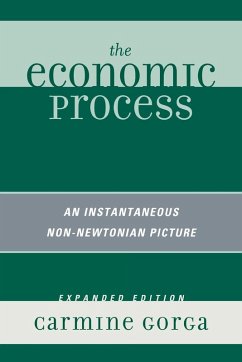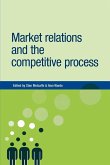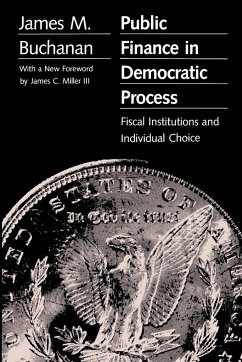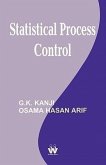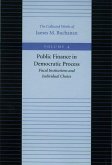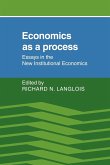- Broschiertes Buch
- Merkliste
- Auf die Merkliste
- Bewerten Bewerten
- Teilen
- Produkt teilen
- Produkterinnerung
- Produkterinnerung
This book transports the reader from the world of mainstream economics, in which the object of observation is The Market (exchange), to a world in which the object of observation is the economic process. Both producer and consumer must, respectively, be legitimate owners of real wealth and monetary wealth.
Andere Kunden interessierten sich auch für
![Market relations and the competitive process Market relations and the competitive process]() Market relations and the competitive process37,99 €
Market relations and the competitive process37,99 €![Public Finance in Democratic Process Public Finance in Democratic Process]() James M. BuchananPublic Finance in Democratic Process50,99 €
James M. BuchananPublic Finance in Democratic Process50,99 €![Statistical Process Control Statistical Process Control]() Statistical Process Control69,99 €
Statistical Process Control69,99 €![Bridging Research and Policy in Development: Evidence and the Change Process Bridging Research and Policy in Development: Evidence and the Change Process]() Julius CourtBridging Research and Policy in Development: Evidence and the Change Process34,99 €
Julius CourtBridging Research and Policy in Development: Evidence and the Change Process34,99 €![The Privatization Process The Privatization Process]() The Privatization Process56,99 €
The Privatization Process56,99 €![Public Finance in Democratic Process Public Finance in Democratic Process]() James M BuchananPublic Finance in Democratic Process14,99 €
James M BuchananPublic Finance in Democratic Process14,99 €![Economics as a Process Economics as a Process]() Economics as a Process26,99 €
Economics as a Process26,99 €-
-
-
This book transports the reader from the world of mainstream economics, in which the object of observation is The Market (exchange), to a world in which the object of observation is the economic process. Both producer and consumer must, respectively, be legitimate owners of real wealth and monetary wealth.
Hinweis: Dieser Artikel kann nur an eine deutsche Lieferadresse ausgeliefert werden.
Hinweis: Dieser Artikel kann nur an eine deutsche Lieferadresse ausgeliefert werden.
Produktdetails
- Produktdetails
- Verlag: University Press of America
- Seitenzahl: 432
- Erscheinungstermin: 14. Dezember 2009
- Englisch
- Abmessung: 229mm x 152mm x 25mm
- Gewicht: 697g
- ISBN-13: 9780761849537
- ISBN-10: 076184953X
- Artikelnr.: 28114868
- Herstellerkennzeichnung
- Libri GmbH
- Europaallee 1
- 36244 Bad Hersfeld
- gpsr@libri.de
- Verlag: University Press of America
- Seitenzahl: 432
- Erscheinungstermin: 14. Dezember 2009
- Englisch
- Abmessung: 229mm x 152mm x 25mm
- Gewicht: 697g
- ISBN-13: 9780761849537
- ISBN-10: 076184953X
- Artikelnr.: 28114868
- Herstellerkennzeichnung
- Libri GmbH
- Europaallee 1
- 36244 Bad Hersfeld
- gpsr@libri.de
Carmine Gorga, Ph.D., former Fulbright Scholar, integrates economic theory with logic, mathematics, political science, law, and economic policy and has been assisted in this work by Professor Franco Modigliani, a Nobel laureate in economics at MIT, for twenty-seven years.
Chapter 1 List of Illustrations Chapter 2 A Synopsis Chapter 3
Acknowledgments Chapter 4 Preface to Expanded Edition Chapter 5 Preface
Part 6 Prolegomena (Preliminaries) Chapter 7 The Need to Transform Economic
Theory Chapter 8 ...Into "Simple" and "Obvious" Economics Part 9 Part I:
Overall Analysis of the Keynes' Model Chapter 10 I. Keynes' Thought as the
Apex of Classical Economics Chapter 11 II. Toward Concordian Economics
Chapter 12 III. Lack of Homogeneity in Keynes' Model Chapter 13 IV.
Simplicism - and Forced Doublespeak - of Keynes' Model Chapter 14 V. Lack
of True Equivalence in Keynes' Model Chapter 15 VI. Neither Classical nor
Mainstream, but Rational Economics Part 16 Part II: Analysis of the
Component Elements of Keynes' Model Chapter 17 VII. The Dissection of
Keynes' Model and the Dissection of th S-I Nexus Chapter 18 VIII. The
History of the Word "Saving" Chapter 19 IX. Beyond Adam Smith's Conception
of Saving Chapter 20 X. Beyond Keynes' "Definition" of Investment Chapter
21 XI. The Definition of Saving, Hoarding, and Investment Chapter 22 XII.
The Real Saving-Investment System Chapter 23 XIII. A Sartorial Movement:
Turning Keynes' Model Inside Out or Turning Mainstream Economics into
Concordian Economics Chapter 24 XIV: The Concept of Consumption Chapter 25
XV. The Concept of Income and the Flows Model as a Whole Part 26 Part III:
Analysis of the Economic Process Chapter 27 XVI. The Economic Process as a
Whole Chapter 28 XVII. Simplistic Descriptions of the Economic Process
Chapter 29 XVIII. The Production Process Chapter 30 XIX. The Consumption
Process Chapter 31 XX. The Distribution Process Chapter 32 XXI. Economic
Growth: The Normal Outcome of the Unfolding of the Economic Process Chapter
33 XXII. Inflation: The Outcome of the Economic Process Gone Awry Part 34
Part IV: Foundations of Economics Chapter 35 XXIII. Toward Econometrics:
Closing the Gap Between Micro and Macro Economics Part 36 Part V:
Consciousness and Conscience of Economics Chapter 37 XXIV. Poverty and the
Economic Process Chapter 38 XXV. The Elimination of Absolute Poverty
Through the Right to Create All the Wealth One Needs Chapter 39 Epilogue:
Come To Concord Chapter 40 Appendix 1 - Symbols, Meanings, and Definitions
Chapter 41 Appendix 2 - Concordian Economics: Tools to Return Relevance to
Economics Chapter 42 Appendix 3 - Economics for Physicists and Ecologists
Chapter 43 Endnotes Chapter 44 Index
Acknowledgments Chapter 4 Preface to Expanded Edition Chapter 5 Preface
Part 6 Prolegomena (Preliminaries) Chapter 7 The Need to Transform Economic
Theory Chapter 8 ...Into "Simple" and "Obvious" Economics Part 9 Part I:
Overall Analysis of the Keynes' Model Chapter 10 I. Keynes' Thought as the
Apex of Classical Economics Chapter 11 II. Toward Concordian Economics
Chapter 12 III. Lack of Homogeneity in Keynes' Model Chapter 13 IV.
Simplicism - and Forced Doublespeak - of Keynes' Model Chapter 14 V. Lack
of True Equivalence in Keynes' Model Chapter 15 VI. Neither Classical nor
Mainstream, but Rational Economics Part 16 Part II: Analysis of the
Component Elements of Keynes' Model Chapter 17 VII. The Dissection of
Keynes' Model and the Dissection of th S-I Nexus Chapter 18 VIII. The
History of the Word "Saving" Chapter 19 IX. Beyond Adam Smith's Conception
of Saving Chapter 20 X. Beyond Keynes' "Definition" of Investment Chapter
21 XI. The Definition of Saving, Hoarding, and Investment Chapter 22 XII.
The Real Saving-Investment System Chapter 23 XIII. A Sartorial Movement:
Turning Keynes' Model Inside Out or Turning Mainstream Economics into
Concordian Economics Chapter 24 XIV: The Concept of Consumption Chapter 25
XV. The Concept of Income and the Flows Model as a Whole Part 26 Part III:
Analysis of the Economic Process Chapter 27 XVI. The Economic Process as a
Whole Chapter 28 XVII. Simplistic Descriptions of the Economic Process
Chapter 29 XVIII. The Production Process Chapter 30 XIX. The Consumption
Process Chapter 31 XX. The Distribution Process Chapter 32 XXI. Economic
Growth: The Normal Outcome of the Unfolding of the Economic Process Chapter
33 XXII. Inflation: The Outcome of the Economic Process Gone Awry Part 34
Part IV: Foundations of Economics Chapter 35 XXIII. Toward Econometrics:
Closing the Gap Between Micro and Macro Economics Part 36 Part V:
Consciousness and Conscience of Economics Chapter 37 XXIV. Poverty and the
Economic Process Chapter 38 XXV. The Elimination of Absolute Poverty
Through the Right to Create All the Wealth One Needs Chapter 39 Epilogue:
Come To Concord Chapter 40 Appendix 1 - Symbols, Meanings, and Definitions
Chapter 41 Appendix 2 - Concordian Economics: Tools to Return Relevance to
Economics Chapter 42 Appendix 3 - Economics for Physicists and Ecologists
Chapter 43 Endnotes Chapter 44 Index
Chapter 1 List of Illustrations Chapter 2 A Synopsis Chapter 3
Acknowledgments Chapter 4 Preface to Expanded Edition Chapter 5 Preface
Part 6 Prolegomena (Preliminaries) Chapter 7 The Need to Transform Economic
Theory Chapter 8 ...Into "Simple" and "Obvious" Economics Part 9 Part I:
Overall Analysis of the Keynes' Model Chapter 10 I. Keynes' Thought as the
Apex of Classical Economics Chapter 11 II. Toward Concordian Economics
Chapter 12 III. Lack of Homogeneity in Keynes' Model Chapter 13 IV.
Simplicism - and Forced Doublespeak - of Keynes' Model Chapter 14 V. Lack
of True Equivalence in Keynes' Model Chapter 15 VI. Neither Classical nor
Mainstream, but Rational Economics Part 16 Part II: Analysis of the
Component Elements of Keynes' Model Chapter 17 VII. The Dissection of
Keynes' Model and the Dissection of th S-I Nexus Chapter 18 VIII. The
History of the Word "Saving" Chapter 19 IX. Beyond Adam Smith's Conception
of Saving Chapter 20 X. Beyond Keynes' "Definition" of Investment Chapter
21 XI. The Definition of Saving, Hoarding, and Investment Chapter 22 XII.
The Real Saving-Investment System Chapter 23 XIII. A Sartorial Movement:
Turning Keynes' Model Inside Out or Turning Mainstream Economics into
Concordian Economics Chapter 24 XIV: The Concept of Consumption Chapter 25
XV. The Concept of Income and the Flows Model as a Whole Part 26 Part III:
Analysis of the Economic Process Chapter 27 XVI. The Economic Process as a
Whole Chapter 28 XVII. Simplistic Descriptions of the Economic Process
Chapter 29 XVIII. The Production Process Chapter 30 XIX. The Consumption
Process Chapter 31 XX. The Distribution Process Chapter 32 XXI. Economic
Growth: The Normal Outcome of the Unfolding of the Economic Process Chapter
33 XXII. Inflation: The Outcome of the Economic Process Gone Awry Part 34
Part IV: Foundations of Economics Chapter 35 XXIII. Toward Econometrics:
Closing the Gap Between Micro and Macro Economics Part 36 Part V:
Consciousness and Conscience of Economics Chapter 37 XXIV. Poverty and the
Economic Process Chapter 38 XXV. The Elimination of Absolute Poverty
Through the Right to Create All the Wealth One Needs Chapter 39 Epilogue:
Come To Concord Chapter 40 Appendix 1 - Symbols, Meanings, and Definitions
Chapter 41 Appendix 2 - Concordian Economics: Tools to Return Relevance to
Economics Chapter 42 Appendix 3 - Economics for Physicists and Ecologists
Chapter 43 Endnotes Chapter 44 Index
Acknowledgments Chapter 4 Preface to Expanded Edition Chapter 5 Preface
Part 6 Prolegomena (Preliminaries) Chapter 7 The Need to Transform Economic
Theory Chapter 8 ...Into "Simple" and "Obvious" Economics Part 9 Part I:
Overall Analysis of the Keynes' Model Chapter 10 I. Keynes' Thought as the
Apex of Classical Economics Chapter 11 II. Toward Concordian Economics
Chapter 12 III. Lack of Homogeneity in Keynes' Model Chapter 13 IV.
Simplicism - and Forced Doublespeak - of Keynes' Model Chapter 14 V. Lack
of True Equivalence in Keynes' Model Chapter 15 VI. Neither Classical nor
Mainstream, but Rational Economics Part 16 Part II: Analysis of the
Component Elements of Keynes' Model Chapter 17 VII. The Dissection of
Keynes' Model and the Dissection of th S-I Nexus Chapter 18 VIII. The
History of the Word "Saving" Chapter 19 IX. Beyond Adam Smith's Conception
of Saving Chapter 20 X. Beyond Keynes' "Definition" of Investment Chapter
21 XI. The Definition of Saving, Hoarding, and Investment Chapter 22 XII.
The Real Saving-Investment System Chapter 23 XIII. A Sartorial Movement:
Turning Keynes' Model Inside Out or Turning Mainstream Economics into
Concordian Economics Chapter 24 XIV: The Concept of Consumption Chapter 25
XV. The Concept of Income and the Flows Model as a Whole Part 26 Part III:
Analysis of the Economic Process Chapter 27 XVI. The Economic Process as a
Whole Chapter 28 XVII. Simplistic Descriptions of the Economic Process
Chapter 29 XVIII. The Production Process Chapter 30 XIX. The Consumption
Process Chapter 31 XX. The Distribution Process Chapter 32 XXI. Economic
Growth: The Normal Outcome of the Unfolding of the Economic Process Chapter
33 XXII. Inflation: The Outcome of the Economic Process Gone Awry Part 34
Part IV: Foundations of Economics Chapter 35 XXIII. Toward Econometrics:
Closing the Gap Between Micro and Macro Economics Part 36 Part V:
Consciousness and Conscience of Economics Chapter 37 XXIV. Poverty and the
Economic Process Chapter 38 XXV. The Elimination of Absolute Poverty
Through the Right to Create All the Wealth One Needs Chapter 39 Epilogue:
Come To Concord Chapter 40 Appendix 1 - Symbols, Meanings, and Definitions
Chapter 41 Appendix 2 - Concordian Economics: Tools to Return Relevance to
Economics Chapter 42 Appendix 3 - Economics for Physicists and Ecologists
Chapter 43 Endnotes Chapter 44 Index

